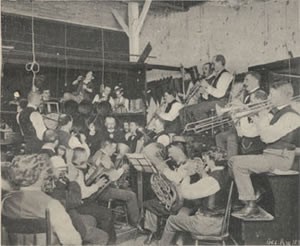
A cramped band makes a recording at the Edison studios, 1900
Less obvious were the many things done in the early recording studios to reshape musical performance for the purpose of recording it. Some performers’ voices sounded better on record than others, and there was no good way to improve a deficient phonograph voice. Singers accustomed to performing on stage, where they could move about freely, had to stand still near the recording horn. Singers also had to control their voices carefully, singing neither too loudly nor too softly, or else they risked over-driving the recording mechanism or singling too softly to be recorded. The studio room itself could affect the sound of the recording. Singers and instruments had to be crowded near the horn, and often the number of instruments called for in symphonic pieces had to be reduced to just a few.
Some instruments simply would not record well and had to be eliminated, and early phonographs could not capture “sibilant” sounds (like the letter ‘s’). Pianos were difficult to record unless placed near the horn. There are even a few examples of musical instruments being modified for recording. The Stroh violin, for example, had a special metal horn attached to it that helped strengthen its sound so it could be heard on records. In all, there were numerous things done behind the scenes in order to record music that had never been necessary with live performance.
In the period from about the 1890s to the 1920s, engineers and experimenters looked for ways to improve the sound of the phonograph. Because they relied on the “acoustic” recording and playback process exclusively, achieving sufficient playback volume was a major issue. Edison and others looked for ways to record on a soft medium and then harden the medium (or transfer the recording to a harder medium) for playback. With the harder medium, the playing stylus could press down hard on the groove, and the result was greater volume.